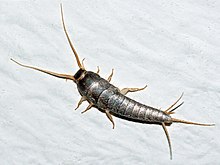Silverfish
|
Lepisma saccharina Temporal range: 400–0 Ma Late Carboniferous to Recent |
|
|---|---|
 |
|
| Scientific classification | |
| Kingdom: | Animalia |
| Phylum: | Arthropoda |
| Subphylum: | Hexapoda |
| Class: | Insecta |
| Subclass: | Apterygota |
| Order: | Thysanura |
| Family: | Lepismatidae |
| Genus: | Lepisma |
| Species: | L. saccharina |
| Binomial name | |
|
Lepisma saccharina Linnaeus, 1758 |
|
| External identifiers for Lepisma saccharina | |
|---|---|
| Encyclopedia of Life | 1022755 |
| ITIS | 99222 |
| NCBI | 50586 |
| Also found in: , ADW | |
A silverfish (Lepisma saccharina) is a small, wingless insect in the order Thysanura. Its common name derives from the animal's silvery light grey and blue color, combined with the fish-like appearance of its movements, while the scientific name (L. saccharina) indicates the silverfish's diet consists of carbohydrates such as sugar or starches.
Silverfish are nocturnal insects typically 13–25 mm (0.5–1.0 in) long. Their abdomens taper at the end, giving them a fish-like appearance. The newly hatched are whitish, but develop a greyish hue and metallic shine as they get older. They have two long cerci and one terminal filament at the tips of their abdomens, the filament projects directly off of the end of their body, between the left and right cerci. They also have two small compound eyes, despite other members of Thysanura being completely eyeless, such as the family Nicoletiidae.
Like other species in Apterygota, silverfish are completely wingless. They have long antennae, and move in a wiggling motion that resembles the movement of a fish. This, coupled with their appearance and silvery scales, influences their common name. Silverfish typically live for two to eight years. Silverfish are agile runners and can outrun most of their predators (including wandering spiders and centipedes). However such running is only possible on horizontal surfaces, as they lack any additional appendages and, therefore, are not fast enough to climb walls at the same speed. They also avoid light.
Silverfish are a cosmopolitan species, found in Africa, the Americas, Australia, Eurasia, and other parts of the Pacific. They inhabit moist areas, requiring a relative humidity between 75% and 95%. In urban areas, they can be found in attics, basements, bathtubs, sinks, kitchens, and showers.
...
Wikipedia
